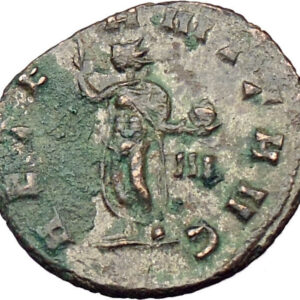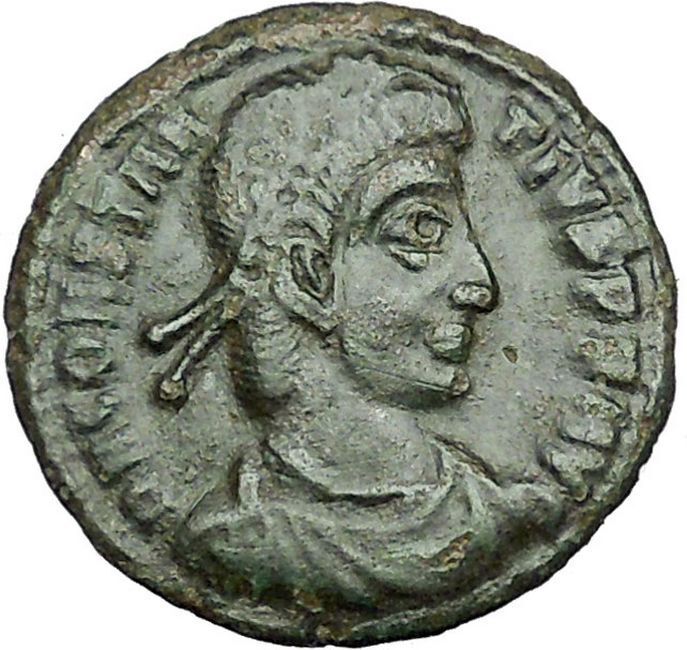|
Antoninus Pius – Roman Emperor: 138-161 A.D.
Bronze As 25mm (8.83 grams) Rome mint: 143-144 A.D.
Reference: RIC III 733; Cohen 450; BMCRE 1624
Certification: NGC Ancients VF 4375823-423
ANTONINVS AVG PIVS P P TR P COS III, laureate head right.
IMPERATOR II S-C, Sow seated right under oak tree, suckling four young, two more before.
Lares Grundules: the thirty “grunting Lares”, supposedly given an altar and cult by Romulus or Aeneas when a sow produced a prodigous farrow of thirty piglets. According to Dionysius of Halicarnassus the place where the sow bore the piglets and Aeneas made the sacrifice was sacred, and forbidden to foreigners. The sow’s body was said to be kept at Lavinium, preserved in salt brine as a sacred object. The thirty piglets would provide the theological justification for the thirty populi Albenses of the feriae Latinae (the thirty fortified boroughs supposedly founded by Aeneas at Lavinium), and the thirty curiae of Rome.
You are bidding on the exact item pictured, provided with a Certificate of Authenticity and Lifetime Guarantee of Authenticity.
Lares (singular Lar), archaically Lases, were guardian deities in ancient Roman religion. Their origin is uncertain; they may have been hero-ancestors, guardians of the hearth, fields, boundaries or fruitfulness, or an amalgam of these.
Lares were believed to observe, protect and influence all that happened within the boundaries of their location or function. The statues of domestic Lares were placed at table during family meals; their presence, cult and blessing seem to have been required at all important family events. Roman writers sometimes identify or conflate them with ancestor-deities, domestic Penates and the hearth. Because of these associations, Lares are sometimes categorised as household gods but some had much broader domains. Roadways, seaways, agriculture, livestock, towns, cities, the state and its military were all under the protection of their particular Lar or Lares. Those who protected local neighbourhoods (vici) were housed in the crossroad shrines (Compitales) which served as a focus for the religious, social and political life of their local, overwhelmingly plebeian communities. Their cult officials included freedmen and slaves, otherwise excluded by status or property qualification from most administrative and religious offices.
Compared to Rome’s major deities Lares had limited scope and potency but archaeological and literary evidence attests to their central role in Roman identity and religious life. By analogy, a homeward-bound Roman could be described as returning ad Larem (to the Lar). Despite official bans on non-Christian cults from the late 4th century AD onwards, unofficial cults to Lares persisted until at least the early 5th century AD.
Lavinium was a port city of Latium, 53 km (33 mi) to the south of Rome, at a median distance between the Tiber river at Ostia and Anzio. The coastline then, as now, was a long strip of beach. Lavinium was on a hill at the southernmost edge of the Silva Laurentina, a dense laurel forest, and the northernmost edge of the Pontine Marshes, a vast malarial tract of wetlands. The basis for the port, the only one between Ostia and Anzio, was evidently the mouth of the Numicus or Numicius river. The Alban hills loom in the background.
The location of Lavinium has never been lost to historians nor does there appear to have been any significant break in its habitation. Today’s settlement remains a walled village of medieval design, Pratica di Mare, in the comune of Pomezia. The latter is a city constructed in 1939 and settled according to a plan of Benito Mussolini, whose engineers completed the millennia-long task of draining and filling the marsh, now the Pontine fields. A brief strip of field separates the large and flourishing city from the village. One Roman gate allows entry into the narrow streets of the village past the Castello Borghese, originally a fortification, purchased along with the village in 1617 by Marcantonio Borghese. The castle and the village are periodically redesigned and updated.[clarification needed Is this still true?] All that remains of the river that once partly surrounded the village is a small stream, the Fosso di Pratica.
Pratica is about 6 km (3.7 mi) from the Tyrrhenian Sea near the top of a slope descending to an alluvial shelf on which a modern air base, Pratica di Mare Air Force Base, a facility of the Aeronautica Militare, has been placed. It has the historical distinction of being the airfield from which Otto Skorzeny flew Il Duce (Benito Mussolini) to safety in Germany after his rescue from imprisonment in a mountain villa. Today the base is both a secure airport for the protection of distinguished visitors to the Rome region and a home for air shows of advanced aircraft. The Fosso di Pratica was re-routed around the end of a runway; however, today’s small brook is in no way compatible with the concept of a port. The sea may well have formerly extended up to the base of the hill, as sites further north, such as Ostia, appear to have retreated one or two miles inland. Ancient Roman seaside villas are no longer on the beach.
Pratica is observably smaller than ancient Lavinium, whose remains crop out in the surrounding fields. Recent archaeological excavations performed to the south date Lavinium to well before the legendary foundation of Rome. It was already fortified in the 7th century BCE and flourishing in the 6th. Lavinium was assimilated by Republican Rome. It was connected to Rome in the north and Ardea to the south by the Via Laurentina. Under the empire it was combined with the mysterious Laurentum, where many wealthy Romans maintained a winter villa, to become Laurolavinium. The nature of the union remains ambiguous.
A number of kilns have been identified within the perimeter of the city walls. Outside the city was a sanctuary dedicated to Sol Indigetes and a vast sanctuary with numerous altars, where the bronze inscribed plaque records that the Dioscuri were being venerated at one of numerous altars.
According to Roman mythology, which links Lavinium more securely to Rome, the city was named by Aeneas in honor of Lavinia, daughter of Latinus, king of the Latins, and his wife, Amata. Aeneas reached Italy and there fought a war against Turnus, the leader of the local Rutuli people. He did not found Rome but Lavinium, the main centre of the Latin league, from which the people of Rome sprang. Aeneas thus links the royal house of Troy with the Roman republic.
The foundation of Lavinium and the Rutulian war are both mentioned prominently in the great Roman epic, the Aeneid by the Mantuan poet Publius Vergilius Maro (Virgil).
In ancient times Lavinium had a close association with the nearby Laurentum. According to Livy, in the 8th century BC at the time when Romulus and Titus Tatius jointly ruled Rome, the ambassadors of the Laurentes came to Rome but were beaten by Tatius’ relatives. The Laurentes complained, but Tatius accorded more weight to the influence of his relatives than to the injury done the Laurentes. When Tatius afterwards visited Lavinium to celebrate an anniversary sacrifice, he was slain in a tumult. Romulus declined to go to war and instead renewed the treaty between Rome and Lavinium.
In 509 BC, after the overthrow of the Roman monarchy, one of Rome’s first two consuls Lucius Tarquinius Collatinus was convinced to leave Rome because of his relation to the kings. He voluntarily went into exile in Lavinium.

Antoninus Pius – 138-161 A.D.
Caesar: 138 A.D. (under Hadrian)
Augustus: 138-161 A.D.
| Adopted son and successor of Hadrian | Husband of Faustina Senior | Father of Faustina Junior and Galerius Antoninus | Grandfather of Commodus, Annius Verus, Lucilla and Aurelius Antoninus | Adoptive father of Marcus Aurelius and Lucius Verus |
Titus Aurelius Fulvus Boionius Arrius Antoninus (19 September 86 – 7 March 161), generally known in English as Antoninus Pius was Roman emperor from 138 to 161. He was the fourth of the Five Good Emperors and a member of the Aurelii. He did not possess the sobriquet “Pius” until after his accession to the throne. Almost certainly, he earned the name “Pius” because he compelled the Senate to deify his adoptive father Hadrian; the Historia Augusta, however, suggests that he may have earned the name by saving senators sentenced to death by Hadrian in his later years.
//
He was the son and only child of Titus Aurelius Fulvus, consul in 89 whose family came from Nemausus (modern Nîmes) and was born near Lanuvium and his mother was Arria Fadilla. Antoninus’ father and paternal grandfather died when he was young and he was raised by Gnaeus Arrius Antoninus, his maternal grandfather, a man of integrity and culture and a friend of Pliny the Younger. His mother married to Publius Julius Lupus (a man of consular rank), Suffect Consul in 98, and bore him a daughter called Julia Fadilla.
As a private citizen between 110 and 115, he married Annia Galeria Faustina the Elder. They had a very happy marriage. She was the daughter of consul Marcus Annius Verus and Rupilia Faustina (a half-sister to Roman Empress Vibia Sabina). Faustina was a beautiful woman, renowned for her wisdom. She spent her whole life caring for the poor and assisting the most disadvantaged Romans.
Having filled with more than usual success the offices of quaestor and praetor, he obtained the consulship in 120; he was next appointed by the Emperor Hadrian as one of the four proconsuls to administer Italia, then greatly increased his reputation by his conduct as proconsul of Asia. He acquired much favor with the Emperor Hadrian, who adopted him as his son and successor on 25 February, 138, after the death of his first adopted son Lucius Aelius, on the condition that Antoninus would in turn adopt Marcus Annius Verus, the son of his wife’s brother, and Lucius, son of Aelius Verus, who afterwards became the emperors Marcus Aurelius and Lucius Verus (colleague of Marcus Aurelius).
On his accession, Antoninus’ name became “Imperator Caesar Titus Aelius Hadrianus Antoninus Augustus Pontifex Maximus”. One of his first acts as Emperor was to persuade the Senate to grant divine honours to Hadrian, which they had at first refused; his efforts to persuade the Senate to grant these honours is the most likely reason given for his title of Pius (dutiful in affection; compare pietas). Two other reasons for this title are that he would support his aged father-in-law with his hand at Senate meetings, and that he had saved those men that Hadrian, during his period of ill-health, had condemned to death. He built temples, theaters, and mausoleums, promoted the arts and sciences, and bestowed honours and financial rewards upon the teachers of rhetoric and philosophy.
In marked contrast to his predecessors Trajan and Hadrian, Antoninus was not a military man. One modern scholar has written “It is almost certain not only that at no time in his life did he ever see, let alone command, a Roman army, but that, throughout the twenty-three years of his reign, he never went within five hundred miles of a legion”. His reign was the most peaceful in the entire history of the Principate; while there were several military disturbances throughout the Empire in his time, in Mauretania, Iudaea, and amongst the Brigantes in Britannia, none of them are considered serious. The unrest in Britannia is believed to have led to the construction of the Antonine Wall from the Firth of Forth to the Firth of Clyde, although it was soon abandoned. He was virtually unique among emperors in that he dealt with these crises without leaving Italy once during his reign, but instead dealt with provincial matters of war and peace through their governors or through imperial letters to the cities such as Ephesus (of which some were publicly displayed). This style of government was highly praised by his contemporaries and by later generations.
Of the public transactions of this period we have scant information, but, to judge by what we possess, those twenty-two years were not remarkably eventful in comparison to those before and after his; the surviving evidence is not complete enough to determine whether we should interpret, with older scholars, that he wisely curtailed the activities of the Roman Empire to a careful minimum, or perhaps that he was uninterested in events away from Rome and Italy and his inaction contributed to the pressing troubles that faced not only Marcus Aurelius but also the emperors of the third century. German historian Ernst Kornemann has had it in his Römische Geschichte [2 vols., ed. by H. Bengtson, Stuttgart 1954] that the reign of Antoninus comprised “a succession of grossly wasted opportunities,” given the upheavals that were to come. There is more to this argument, given that the Parthians in the East were themselves soon to make no small amount of mischief after Antoninus’ passing. Kornemann’s brief is that Antoninus might have waged preventive wars to head off these outsiders.
Scholars place Antoninus Pius as the leading candidate for fulfilling the role as a friend of Rabbi Judah the Prince. According to the Talmud (Avodah Zarah 10a-b), Rabbi Judah was very wealthy and greatly revered in Rome. He had a close friendship with “Antoninus”, possibly Antoninus Pius, who would consult Rabbi Judah on various worldly and spiritual matters.
After the longest reign since Augustus (surpassing Tiberius by a couple of months), Antoninus died of fever at Lorium in Etruria, about twelve miles (19 km) from Rome, on 7 March 161, giving the keynote to his life in the last word that he uttered when the tribune of the night-watch came to ask the password—”aequanimitas” (equanimity). His body was placed in Hadrian’s mausoleum, a column was dedicated to him on the Campus Martius, and the temple he had built in the Forum in 141 to his deified wife Faustina was rededicated to the deified Faustina and the deified Antoninus.
The only account of his life handed down to us is that of the Augustan History, an unreliable and mostly fabricated work. Antoninus is unique among Roman emperors in that he has no other biographies. Historians have therefore turned to public records for what details we know.
Antoninus in many ways was the ideal of the landed gentleman praised not only by ancient Romans, but also by later scholars of classical history, such as Edward Gibbon or the author of the article on Antoninus Pius in the ninth edition of the Encyclopedia Britannicaca:
A few months afterwards, on Hadrian’s death, he was enthusiastically welcomed to the throne by the Roman people, who, for once, were not disappointed in their anticipation of a happy reign. For Antoninus came to his new office with simple tastes, kindly disposition, extensive experience, a well-trained intelligence and the sincerest desire for the welfare of his subjects. Instead of plundering to support his prodigality, he emptied his private treasury to assist distressed provinces and cities, and everywhere exercised rigid economy (hence the nickname κυμινοπριστης “cummin-splitter”). Instead of exaggerating into treason whatever was susceptible of unfavorable interpretation, he spurned the very conspiracies that were formed against him into opportunities for demonstrating his clemency. Instead of stirring up persecution against the Christians, he extended to them the strong hand of his protection throughout the empire. Rather than give occasion to that oppression which he regarded as inseparable from an emperor’s progress through his dominions, he was content to spend all the years of his reign in Rome, or its neighborhood.
|














